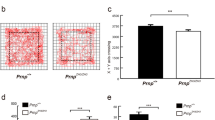Abstract
1. The cellular prion protein, designated PrPc, is a key molecule in the prion diseases but its physiological function remains unknown. To elucidate whether PrPc plays some role in the central nervous system, we established a line of mice in which the PrP gene had been disrupted and subsequently conducted long-term observations.
2. Performance in latent learning and passive avoidance was evaluated using water-finding and step-through tests, respectively.
3. PrP –/– mice showed impaired performance in the water-finding test, indicating a disturbance in latent learning, at 23 weeks of age. In the step-through test, although the PrP –/– mice showed normal learning ability and short-term memory retention, they evidenced a significant disturbance in long-term memory retention.
4. These results indicate that PrPc is needed for certain types of learning and memory and that the loss of function of this protein may contribute to the pathogenesis of prion diseases.
Similar content being viewed by others
REFERENCES
Abraham, W. C., Mason, S. E., Demmer, J., Williams, J. M., Richardson, C. L., Tate, W. P., Lowlor, P. A., and Dragunow, M. (1993). Correlations between immediate early gene induction and the persistence of long-term potentiation. Neuroscience 56:717–727.
Askanas, V., Bilak, M., Engel, W. K., Leclerc, A., and Tom, F. (1993). Prion protein is strongly immunolocalized at the postsynaptic domain of human normal neuromuscular junctions. Neurosci. Lett. 159:111–114.
Borchelt, D. R., Koliatsos, V. E., Guarnieri, M., Pardo, C. A., Sisodia, S. S., and Price, D. L. (1994). Rapid anterograde axonal transport of the cellular prion glycoprotein in the peripheral and central nervous systems. J. Biol. Chem. 269:14711–14717.
Bourtchuladze, R., Frenguelli, B., Blendy, J., Cioffi, D., Schutz, G., and Silva, A. J. (1994). Deficient long-term memory in mice with a targeted mutation of the cAMP-responsive element-binding protein. Cell 79:59–68.
Büeller, H., Fischer, M., Lang, Y., Bluethmann, H., Lipp, H.-P., DeArmond, S. J., Prusiner, S. B., Aguet, M., and Weissmann, C. (1992). Normal development and behavior of mice lacking the neuronal cell-surface PrP protein. Nature 356:577–582.
Colling, S. B., Collinge, J., and Jefferys, J. G. R. (1996). Hippocampal slices from prion protein null mice: Disrupted Ca2+-activated K+ currents. Neurosci. Lett. 209:49–52.
Collinge, J., Whittington, M. A., Sidle, K. C. L., Smith, C. J., Palmer, M. S., Clarke, A. R., and Jefferys, J. G. R. (1994). Prion protein is necessary for normal synaptic function. Nature 370:295–297.
DeZazzo, J., and Tully, T. (1995). Dissection of memory formation: From behavioral pharmacology to molecular genetics. Trends Neurosci. 18:212–218.
Ettenberg, A., Moal, M. L., Koob, G. F., and Bloom, F. E. (1983). Vasopressin potentiation in the performance of a learned appetitive task: Reversal by a pressor antagonist analog of vasopressin. Pharmacol. Biochem. Behav. 18:645–647.
Fournier, J.-G., Escaig-Haye, F., Billette de Villemeur, T., and Robain, O. (1995). Ultrastructural localization of cellular prion protein (PrPc) in synaptic boutons of normal hamster hippocampus. C.R. Acad. Sci. Paris 318:339–344.
Lipp, H.-P., Schwegler, H., Heimrich, B., and Driscoll, P. (1988). Infrapyramidal mossy fibers and two-way avoidance learning: Developmental modification of hippocampal circuitry and adult behavior of rats and mice. J. Neurosci. 8:1905–1921.
Manson, J. C., Clarke, A. R., Hooper, M. L., Aitchison, L., McConnell, I., and Hope, J. (1994). 129/Ola mice carrying a null mutation in PrP that abolishes mRNA production are developmentally normal. Mol. Neurobiol. 8:121–127.
Mayford, M., Bach, M. E., Huang, Y.-Y., Wang, L., Hawkins, R. D., and Kandel, E. R. (1996). Control of memory formation through regulated expression of a CamKII transgene. Science 274:1678–1683.
Moser, M., Colello, R. J., Pott, U., and Oesch, B. (1995). Developmental expression of the prion protein gene in glial cells. Neuron 14:509–517.
Prusiner, S. B. (1991). Molecular biology of prion diseases. Science 252:1515–1522.
Prusiner, S. B., and DeArmond, S. J. (1994). Prion diseases and neurodegeneration. Annu. Rev. Neurosci. 17:311–319.
Sakaguchi, S., Katamine, S., Shigematsu, K., Nakatani, A., Moriuchi, R., Nishida, N., Kurokawa, K., Nakaoke, R., Sato, H., Jishage, K., Kuno, J., Noda, T., and Miyamoto, T. (1995). Accumulation of proteinase K-resistant prion protein (PrP) is restricted by the expression level of normal PrP in mice inoculated with a mouse-adapted strain of the Creutzfeldt-Jakob disease agent. J. Virol. 69:7586–7592.
Sakaguchi, S., Katamine, S., Nishida, N., Moriuchi, R., Shigematsu, K., Sugimoto, T., Nakatani, A., Kataoka, Y., Houtani, T., Shirabe, S., Okada, H., Hasagawa, S., Miyamoto, T., and Noda, T. (1996). Loss of cerebellar Purkinje cells in aged mice homozygous for a disrupted PrP gene. Nature 380:528–531.
Shimada, A., Ohta, A., Akiguchi, I., and Takeda, T. (1993). Age-related deterioration in conditional avoidance task in the SAM-P/10 mouse, and animal model of spontaneous brain atrophy. Brain Res. 608:266–272.
Tobler, I., Gaus, S. E., Deboer, T., Achermann, P., Fischer, M., Rülicke, T., Moser, M., Oesch, B., McBride, P. A., and Manson, J. C. (1996). Altered circadian activity rhythms and sleep in mice-devoid of prion protein. Nature 380:639–642.
Westaway, D., Cooper, C., Turner, S., Da Costa, M., Carlson, G. A., and Prusiner, S. B. (1994). Structure and polymorphism of the mouse prion protein gene. Proc. Natl. Acad. Sci. USA 91:6418–6422.
Author information
Authors and Affiliations
Rights and permissions
About this article
Cite this article
Nishida, N., Katamine, S., Shigematsu, K. et al. Prion Protein Is Necessary for Latent Learning and Long-Term Memory Retention. Cell Mol Neurobiol 17, 537–545 (1997). https://doi.org/10.1023/A:1026315006619
Issue Date:
DOI: https://doi.org/10.1023/A:1026315006619



